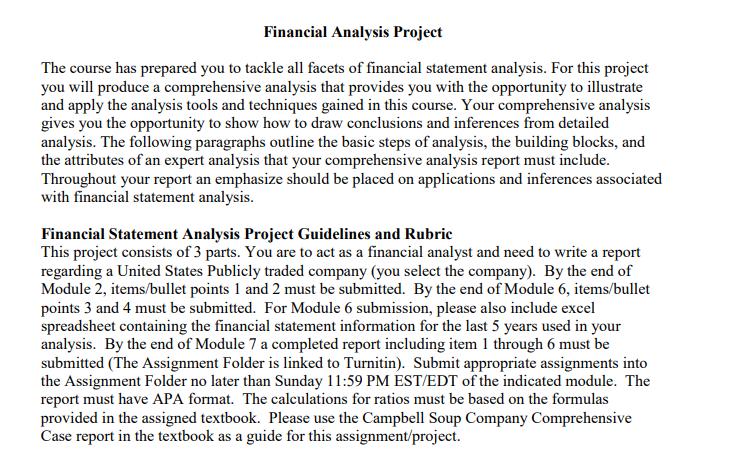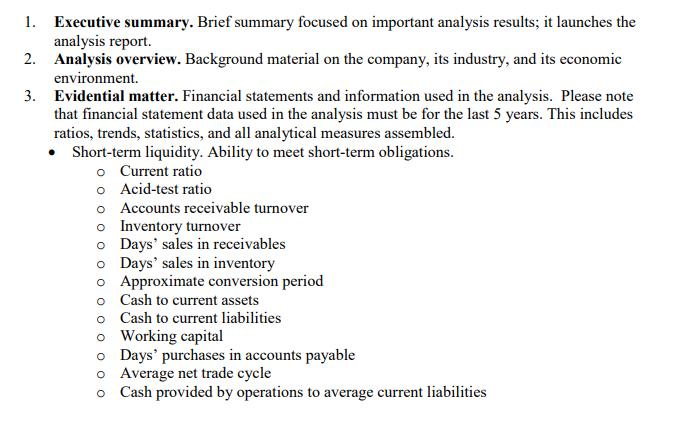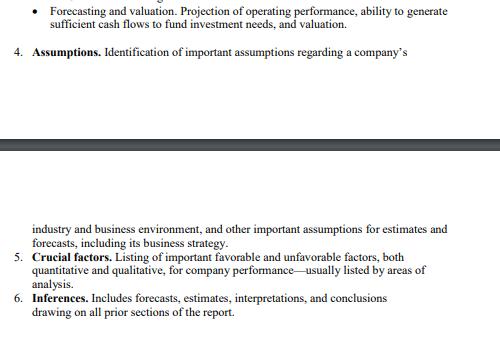Answered step by step
Verified Expert Solution
Question
1 Approved Answer
Financial Analysis Project The course has prepared you to tackle all facets of financial statement analysis. For this project you will produce a comprehensive




Financial Analysis Project The course has prepared you to tackle all facets of financial statement analysis. For this project you will produce a comprehensive analysis that provides you with the opportunity to illustrate and apply the analysis tools and techniques gained in this course. Your comprehensive analysis gives you the opportunity to show how to draw conclusions and inferences from detailed analysis. The following paragraphs outline the basic steps of analysis, the building blocks, and the attributes of an expert analysis that your comprehensive analysis report must include. Throughout your report an emphasize should be placed on applications and inferences associated with financial statement analysis. Financial Statement Analysis Project Guidelines and Rubric This project consists of 3 parts. You are to act as a financial analyst and need to write a report regarding a United States Publicly traded company (you select the company). By the end of Module 2, items/bullet points 1 and 2 must be submitted. By the end of Module 6, items/bullet points 3 and 4 must be submitted. For Module 6 submission, please also include excel spreadsheet containing the financial statement information for the last 5 years used in your analysis. By the end of Module 7 a completed report including item 1 through 6 must be submitted (The Assignment Folder is linked to Turnitin). Submit appropriate assignments into the Assignment Folder no later than Sunday 11:59 PM EST/EDT of the indicated module. The report must have APA format. The calculations for ratios must be based on the formulas provided in the assigned textbook. Please use the Campbell Soup Company Comprehensive Case report in the textbook as a guide for this assignment/project. 1. Executive summary. Brief summary focused on important analysis results; it launches the analysis report. 2. Analysis overview. Background material on the company, its industry, and its economic environment. 3. Evidential matter. Financial statements and information used in the analysis. Please note that financial statement data used in the analysis must be for the last 5 years. This includes ratios, trends, statistics, and all analytical measures assembled. Short-term liquidity. Ability to meet short-term obligations. o Current ratio o Acid-test ratio o Accounts receivable turnover o Inventory turnover o Days' sales in receivables o Days' sales in inventory o Approximate conversion period o Cash to current assets o Cash to current liabilities o Working capital o Days' purchases in accounts payable o Average net trade cycle o Cash provided by operations to average current liabilities Capital structure and solvency. Ability to generate future revenues and meet long-term obligations. o Total debt to equity Total debt ratio o o Long-term debt to equity Equity to total debt o o Fixed assets to equity o Current liabilities to total liabilities o Earnings to fixed charges o Cash flow to fixed charges o Times Interest Earned Return on invested capital. Ability to provide financial rewards sufficient to attract and retain financing. O Return on net operating assets-(RNOA) Return on common equity-(ROCE) o Return on long-term debt and equity o o Equity growth rate o Disaggregation of ROCE o Disaggregation of RNOA o Return on Total Assets o Return on Common Equity . Asset turnover. Asset intensity in generating revenues to reach a sufficient profitability level. o Sales to cash and equivalents o Sales to receivables o Sales to inventories o Sales to working capital o Sales to fixed assets. o Sales to other assets o Sales to total assets o Sales to short-term liabilities O Cash turnover o Account Receivable Turnover o Inventory Turnover o Working Capital Turnover o Fixed Assets Turnover o Total Assets Turnover Forecasting and valuation. Projection of operating performance, ability to generate sufficient cash flows to fund investment needs, and valuation. 4. Assumptions. Identification of important assumptions regarding a company's industry and business environment, and other important assumptions for estimates and forecasts, including its business strategy. 5. Crucial factors. Listing of important favorable and unfavorable factors, both quantitative and qualitative, for company performance usually listed by areas of analysis. 6. Inferences. Includes forecasts, estimates, interpretations, and conclusions drawing on all prior sections of the report.
Step by Step Solution
★★★★★
3.34 Rating (157 Votes )
There are 3 Steps involved in it
Step: 1
Executive Summary Caterpillar is a leading manufacturing company dealing in construction and mining equipment Caterpillar established in 1925 has more than 100 years of practice and knowledge Benjamin ...
Get Instant Access to Expert-Tailored Solutions
See step-by-step solutions with expert insights and AI powered tools for academic success
Step: 2

Step: 3

Ace Your Homework with AI
Get the answers you need in no time with our AI-driven, step-by-step assistance
Get Started


